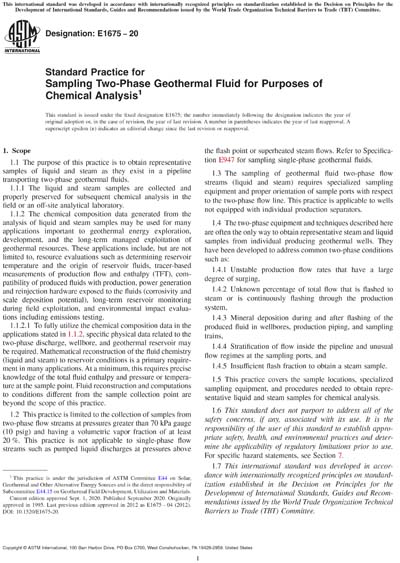Most recent
ASTM E1675-20
Standard Practice for Sampling Two-Phase Geothermal Fluid for Purposes of Chemical Analysis
1.1 The purpose of this practice is to obtain representative samples of liquid and steam as they exist in a pipeline transporting two-phase geothermal fluids.
1.1.1 The liquid and steam samples are collected and properly preserved for subsequent chemical analysis in the field or an off-site analytical laboratory.
1.1.2 The chemical composition data generated from the analysis of liquid and steam samples may be used for many applications important to geothermal energy exploration, development, and the long-term managed exploitation of geothermal resources. These applications include, but are not limited to, resource evaluations such as determining reservoir temperature and the origin of reservoir fluids, tracer-based measurements of production flow and enthalpy (TFT), compatibility of produced fluids with production, power generation and reinjection hardware exposed to the fluids (corrosivity and scale deposition potential), long-term reservoir monitoring during field exploitation, and environmental impact evaluations including emissions testing.
1.1.2.1 To fully utilize the chemical composition data in the applications stated in 1.1.2, specific physical data related to the two-phase discharge, wellbore, and geothermal reservoir may be required. Mathematical reconstruction of the fluid chemistry (liquid and steam) to reservoir conditions is a primary requirement in many applications. At a minimum, this requires precise knowledge of the total fluid enthalpy and pressure or temperature at the sample point. Fluid reconstruction and computations to conditions different from the sample collection point are beyond the scope of this practice.
1.2 This practice is limited to the collection of samples from two-phase flow streams at pressures greater than 70 kPa gauge (10 psig) and having a volumetric vapor fraction of at least 20 %. This practice is not applicable to single-phase flow streams such as pumped liquid discharges at pressures above the flash point or superheated steam flows. Refer to Specification E947 for sampling single-phase geothermal fluids.
1.3 The sampling of geothermal fluid two-phase flow streams (liquid and steam) requires specialized sampling equipment and proper orientation of sample ports with respect to the two-phase flow line. This practice is applicable to wells not equipped with individual production separators.
1.4 The two-phase equipment and techniques described here are often the only way to obtain representative steam and liquid samples from individual producing geothermal wells. They have been developed to address common two-phase conditions such as:
1.4.1 Unstable production flow rates that have a large degree of surging,
1.4.2 Unknown percentage of total flow that is flashed to steam or is continuously flashing through the production system,
1.4.3 Mineral deposition during and after flashing of the produced fluid in wellbores, production piping, and sampling trains,
1.4.4 Stratification of flow inside the pipeline and unusual flow regimes at the sampling ports, and
1.4.5 Insufficient flash fraction to obtain a steam sample.
1.5 This practice covers the sample locations, specialized sampling equipment, and procedures needed to obtain representative liquid and steam samples for chemical analysis.
1.6 This standard does not purport to address all of the safety concerns, if any, associated with its use. It is the responsibility of the user of this standard to establish appropriate safety, health, and environmental practices and determine the applicability of regulatory limitations prior to use. For specific hazard statements, see Section 7.
1.7 This international standard was developed in accordance with internationally recognized principles on standardization established in the Decision on Principles for the Development of International Standards, Guides and Recommendations issued by the World Trade Organization Technical Barriers to Trade (TBT) Committee.
ASTM International [astm]

